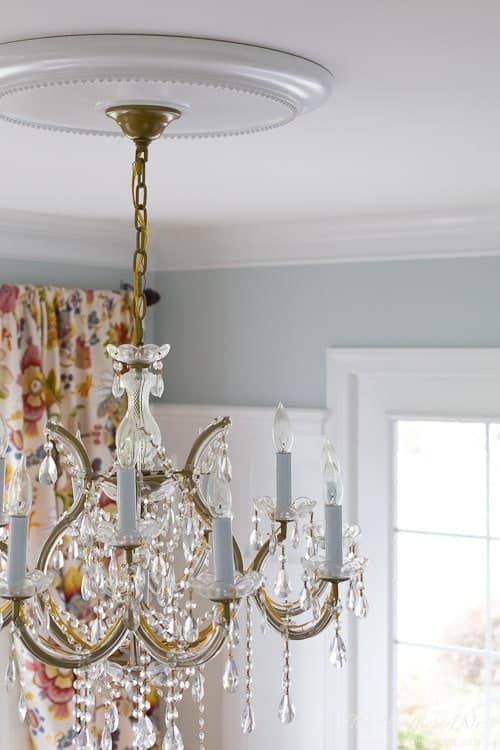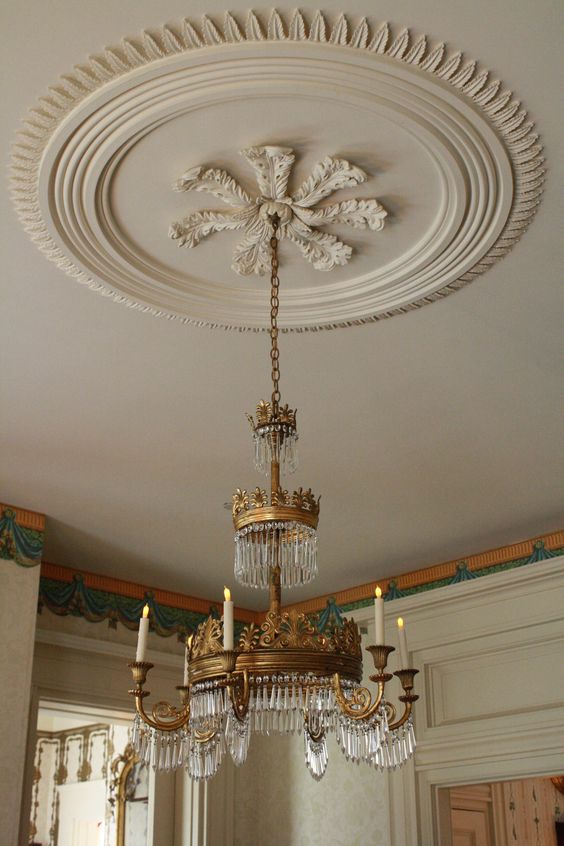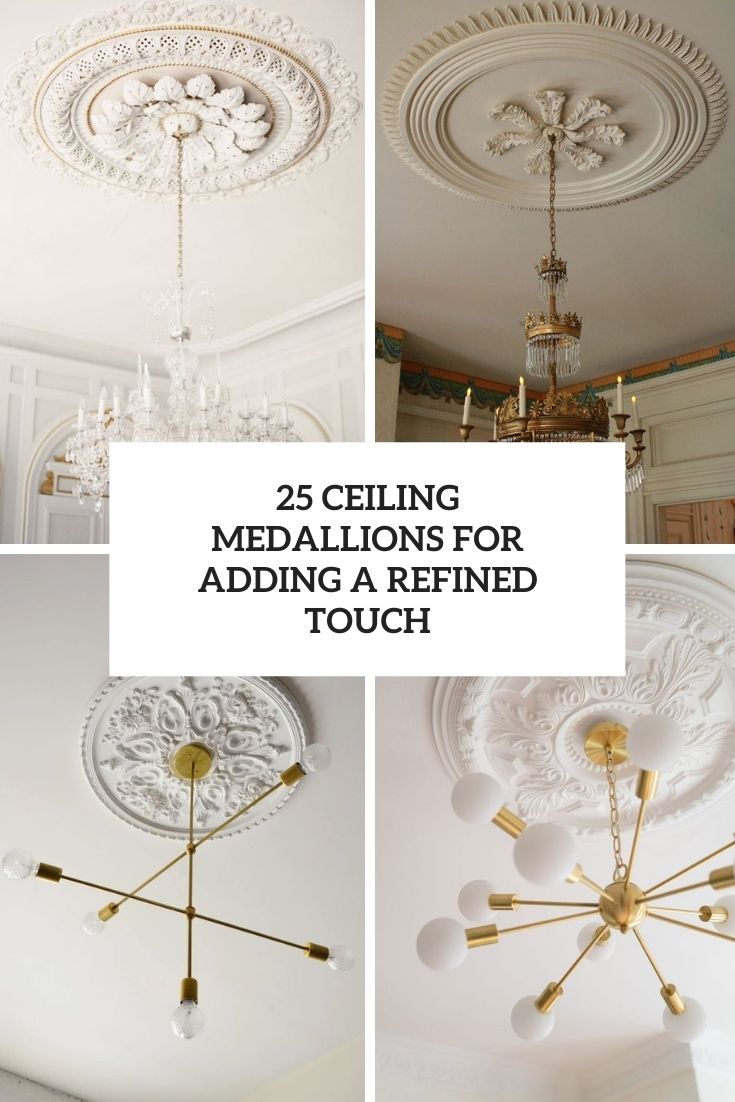A ceiling medallion is a decorative detail that’s generally round in shape and the purpose of which is to add visual interest and draw attention to a hanging light fixture, such as a chandelier. These ornamental features first started to appear in the early decades of the 19th century, mainly in wealthier Victorian-style homes where they were used in large or important gathering rooms, such as a formal living or dining room.
The medallions’ appearance and the materials that they were made from varied greatly. Some were plain, simple round disks while others were highly detailed with elaborate carvings inspired by flowers and leaf motifs or classical Italian and Greek designs. The wealthier the homeowners and the grander the estate, the more luxurious the ceiling medallion designs. As for the materials that were used to make them, most were made from papier-mâché. Plaster, plaster of Paris, and wood were also commonly used by the artisans who created them.
The purpose of ceiling medallions was the same in the 19th century as it remains today; first, they are used for a visual purpose—to accentuate the ceiling’s focal point, a hanging light fixture, and to add a decorative element and an air of grandeur to a room. Second, they have always been used for a practical reason as well. Back in the day, one of those was to hide soot and dirt around the light, which isn’t necessarily a need today—though hiding an electrical box and wiring still certainly makes sense as a reason now.
If you’re thinking about adding a ceiling medallion in your own home, here are some things to consider when choosing what type would best suit your space.
Consider The Style
Consider the style and architecture of your home, the furniture and decor that you have, and the light fixture that you will be using with the medallion. As you do that, it’ll give you clues as to what type of ceiling medallion you should be looking for. If you live in a more traditional home that has elaborate chair rails and crown molding, or even historical architectural features, an ornate medallion will complement those elements well and won’t look out of place or clash with everything else going on in the room. And, on the other hand, if you live in a more contemporary house and aren’t going to be hanging a big crystal chandelier, it’s best to use a simpler medallion design. This doesn’t mean that it needs to be completely plain, just feature less detail and cleaner lines than a highly traditional medallion does.

A beautiful and chic white ceiling medallion with a gold modern chandelier and bulbs on it is a lovely idea for a refined look.

A breathtaking white ceiling medallion with petals and a beautiful and airy crystal chandelier with faux candles for a wow look.

A chic vintage white ceiling medallion with patterns feturing a cluster of modern black and gold pendant lamps looks unusual in contrast with them.

A glam and chic ceiling medallion with an oversized crystal chandelier with taupe lampshades look amazing with each other and add elegance to the room.

A gold sunburst ceiling medallion paired with a gold chandelier and bulbs for a super chic and elegant look.

A jaw-dropping ceiling medallion plus a simple pendant lamp - if your medallion is very large and refined, keep the lamp simple.

A light blue ceiling medallion and a vintage metal chandelier with green lampshades for adding color and a chic vintage feel to the space.

A lovely neutral Scandinavian space with a large and refined ceiling medallion and a chic black chandelier over the space.

A modern sleek ceiling medallion complemented with a super chic vintage chandelier with crystals hanging down and faux candles.

A refined white ceiling medallion paired with an absolutely jaw-dropping modern chandelier with long white bulbs.

A refined white ceiling medallion to accent a stylish mid-century modern gold ray chandelier with bulbs for a stylish modern room.

A Scandinavian bedroom with a chic and cool ceiling medallion, a black pendant lamp with mesh and a bulb for a contrast.
Consider The Size
When trying to figure out what size ceiling medallion you need, consider not just the size of the room it’s going in but also the light fixture that it will be used with. In simple terms, the larger the size of the room and height of the ceiling, the larger the light fixture that you need, and therefore, the larger the ceiling medallion can be.
To determine the ideal diameter of a medallion for your space, you’ll need certain dimensions. First, measure the length and the width of the room and multiply those numbers. That will give the square footage. Once you have that number, divide it by seven; that number is the diameter of the ceiling medallion that you need.
This is a good rule of thumb, but besides the size of the room, make sure to measure your light fixture as well. You want the diameter of the medallion to be about the same size as the diameter of the light. If you’re working with a particularly large room that has an exceptionally tall ceiling, another option is layering two different sized medallions together to create extra drama and add even more dimension, or use multiple medallions with multiple lights. Get inspired by the beautiful ideas we’ve gathered!

A sleek white ceiling medallion that accents a statement and oversized crystal and brass chandelier look wow together.

A sophisticated ceiling medallion made of patterns attached right to the ceiling to form it, a crystal chandelier to finish off the look.

A stylish and cool ceiling medalltion paired with a black modern lamp with three parts to create a bold contrast and keep up the style of the space.

A stylish ceiling medallion and a pendant sphere lamp on gold chain bring enough elegance to the space matching its style a lot.

A very simple and sleek ceiling medallion and a whimsical chandelier with multiple bulbs for accenting a mid-century modern dining room.

A white ceiling medallion paired with a crystal chandelier, with candles and crystals hanging down for adding vintage chic to the space.

A white ceiling medallion with a gold sunburst chandelier - the vintage look of the medallion and modern look of the chandelier contrast.

A white patterned ceiling medallion and a modern brass chandelier with bulbs are a lovely pair to rock, they will make your space ultimate.

An elegant and pretty simple ceiling medallion and a mid-century mmodern chandelier with a gold base and forsted glass lampshades for a refined look.

An oversized and chic ceiling medallion and an ultra-modern pendant lamp with white glass for a mid-century modern dining room.

An oversized beautiful ceiling medallion formed of pieces attached right to the ceiling and a stylish mid-century modern chandelier with smoked glass.

An oversized refined off-white ceiling medallion that matches the color of the ceiling and a whimsical crystal and gold chandelier with candles.

An oversized white ceiling medallion and a white fan that doesn't distract attention from the medallion.
